Experiments
A biologist is observing an organism under a microscope and concludes that it is a unicellular organism. Which of the following observations provides evidence that this organism must be unicellular, not multicellular?
a. It can make its own food.
b. It can move on its own.
c. It cannot be seen without a microscope.
d. It performs all functions to maintain life.
d. It performs all functions to maintain life.
Reason: A unicellular organism must be able to perform all life functions on its own. In a multicellular organism, jobs can be divided among all the different types of cells.
Temperature affects how energy is transferred. To show this, students place a metal spoon that is room temperature into a bowl of hot soup for 60 seconds. When the students take the spoon out of the soup, what changes will have occurred?
a. The spoon is colder.
b. The spoon made the soup warmer.
c. The spoon’s particles are moving faster.
d. There has been no change in the movement of the soup’s or the spoon’s particles
c. The spoon’s particles are moving faster.
Reason: the temperature of the spoon increases because the heat is transferred to the spoon from the soup, so the spoon has faster moving particles.
An environmental geologist is conducting a study in an area to learn if contamination from a local factory is affecting the ground environment. She is designing an instrument that needs to determine the effects on the soil and groundwater. This instrument should also take these data and map or graph them to show the effects of pollution in an area.
Her students come up with a few different instrument designs. The table below shows examples of data from each student’s design.

Student 2
Reason: The scientist’s criteria for a design were that it needs to determine the effects on the soil and groundwater, and can map or graph these data to show the effects of pollution in an area. This is the only design that meets all criteria.
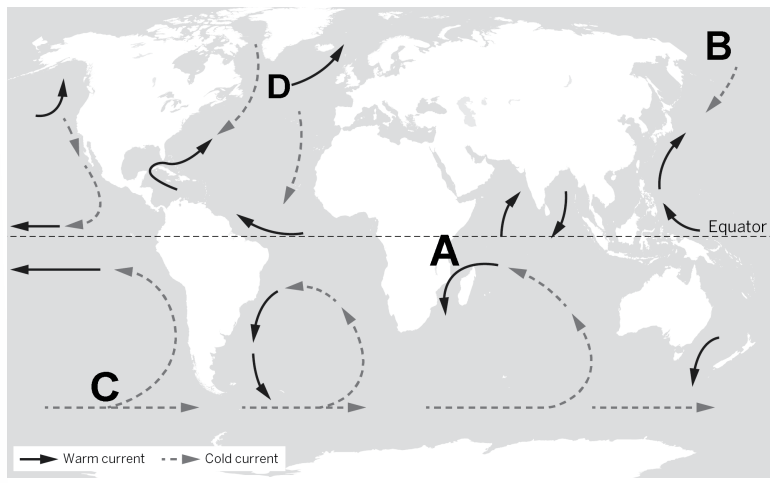
Raquel thinks that the current that carries the most energy is located at the area labeled A. Is this an accurate statement, yes or no?
Yes
Reason: the closer a location is to the equator, the more energy it receives from the sun. Therefore, the current at location A carries the most energy and moves warm water from the equator.
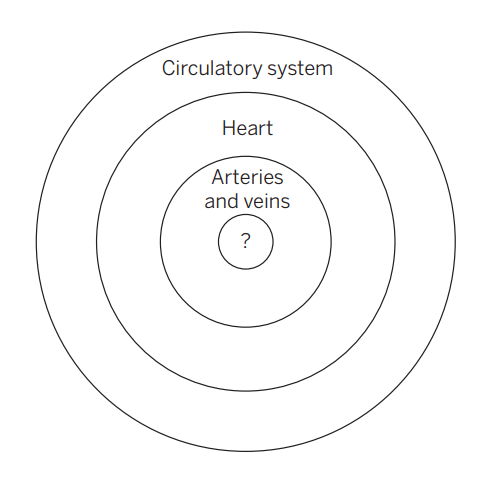
A student is making a model of the cardiovascular system, showing the different components, or levels, that make up this system. Which component of the system is indicated by the question mark (?) in the model?
a. blood cells
b. heart cells
c. respiratory cells
d. cells of other organs
Blood Cells
Reason: This model shows the levels that make up the components of the cardiovascular system, from the blood cells to the organs.
A student claims that thermal energy transfers between objects. Which of the following will test the student’s claim?
a. Place a glass of room temperature water out on the counter, and monitor its temperature.
b. Place ice cubes into a mug of hot chocolate, and watch as the hot chocolate melts the ice cubes.
c. Place a slice of room temperature bread in a toaster, and monitor the temperature of the toaster.
d. Place a container of ice cream in the freezer, and watch as the freezer keeps the ice cream from melting.
b. Place ice cubes into a mug of hot chocolate, and watch as the hot chocolate melts the ice cubes.
Reason: Heat flows from the warmer object toward the colder object until the temperatures become equal. In this case, the hot chocolate is melting the ice cubes.
A science class is planting a vegetable garden. The students want to design a plan to protect the garden from flooding. They want their plan to 1. predict when a flood is coming, 2. protect the vegetables in case of a flood, and 3. not harm the vegetables. The groups’ proposed solutions are recorded in the table below.
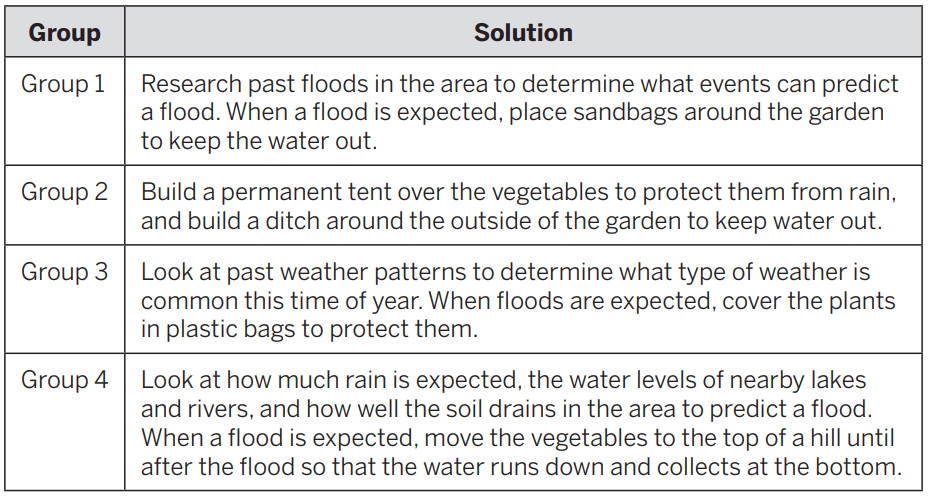
Which group has the best solution?
Group 1
Reason: This is the only plan that meets all of the criteria.
Which of the following accurately explains a cause-and-effect relationship between humans and the environment?
a. As humans use more fossil fuels, air pollution increases.
b. The growth rate of humans is the same as the growth rate of animals.
c. Pollution decreases as a result of humans using nonrenewable resources.
d. Within the last few decades, sea levels have increased and population growth in the United States has slowed.
a. As humans use more fossil fuels, air pollution increases.
Mutations are structural changes to genes that may affect proteins. Some mutations are beneficial, meaning that they help the organism. Some mutations are harmful because they reduce the organism’s ability to survive or reproduce. Other mutations neither help nor harm the organism. These are called neutral mutations. The three images below show organisms with mutations.
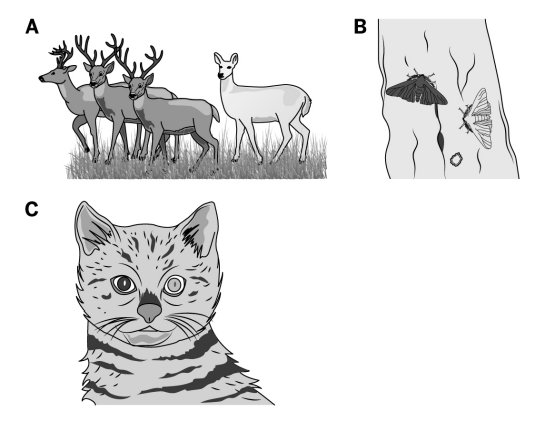
C. The cat with two different colored eyes.
Reason: The mutation that results in two different eye colors in an animal will unlikely help or hinder its survival.
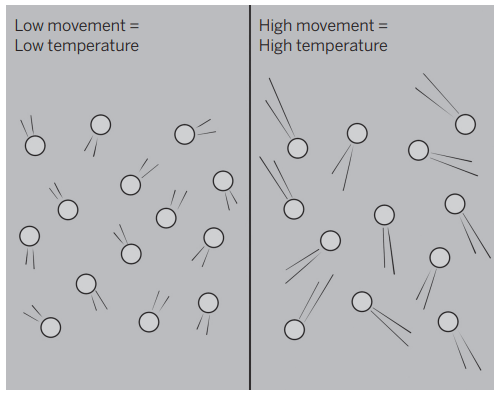
Which picture represents molecules with more kinetic energy?
The high movement/ high temperature picture.
Friction is a force of resistance. It resists the motion of objects that slide against each other. Science students wish to demonstrate that heat is produced when objects in motion have friction. To do this, the students set up four demonstrations.

Which demonstration best shows the concept of heat produced by friction?
Test 3
Reason: This shows friction, which will produce a thermal reaction caused by the resisting/opposing forces when the two surfaces rub together.
Maria lives in a town that is next to a big pond, while Sanjay’s town has no water sources like lakes or ponds. Whose town is likely to get more rain? Explain your answer.
a. Sanjay - the less surface water there is, the more water vapor, and therefore, more rainfall there will likely be.
b. Sanjay - the less surface water there is, the less water vapor, and therefore, more rainfall there will likely be.
c. Maria - the more surface water there is, the more runoff, and therefore, more rain there will likely be.
d. Maria - the more surface water there is, the more water vapor, and therefore, more rainfall there will likely be.
d. Maria - the more surface water there is, the more water vapor, and therefore, more rainfall there will likely be.
Reason: The more surface water there is (like a pond), the more water vapor (and therefore condensation), which leads to more rainfall.
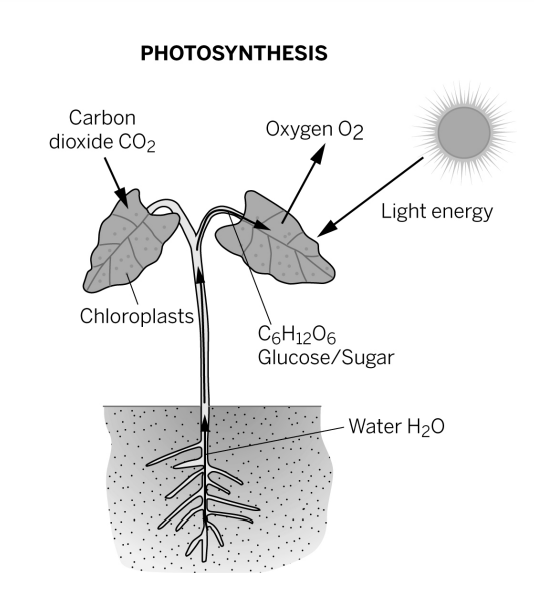
The image shows how a plant uses light energy to make food. Choose the statement that best describes the chemical process of photosynthesis.
a. Carbon dioxide and oxygen are changed into glucose and water.
b. Carbon dioxide and water are changed into glucose and oxygen.
c. Glucose and oxygen are changed into water and carbon dioxide.
d. Oxygen and water are changed into carbon dioxide and glucose.
b. Carbon dioxide and water are changed into glucose and oxygen.
Reason: The model shows carbon dioxide, water and the sun’s energy being taken in by the plant to make sugars and oxygen.
12 Changes in energy drive the water cycle, shown in this diagram below.
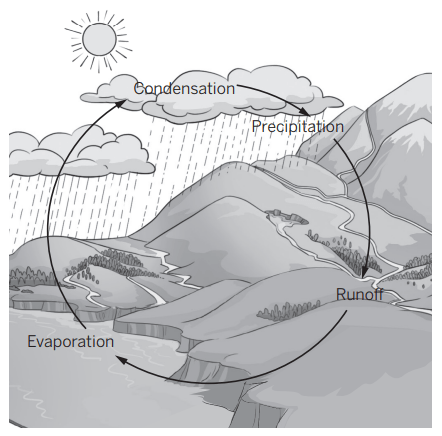
Which statement describes one way in which energy transfers through the water cycle?
a. Energy from the sun causes water in the river to evaporate.
b. Runoff from mountains requires energy to form condensation.
c. Energy from the clouds causes shadows, which decreases runoff.
d. Energy from precipitation causes water to freeze on mountaintops.
a. Energy from the sun causes water in the river to evaporate.
Reason: The energy or heat from the sun causes water in the river to evaporate
An engineer wants to design a building that will stay standing during tornadoes in Nebraska. Which of the following is the best design process for him to follow?
a. He should make models of buildings made of different materials, recreate conditions that are common in tornadoes and observe how the buildings hold up in those conditions. He should then modify the building designs and run the test again.
b. He should make model buildings with different materials, research the history of tornadoes in Nebraska to find out what they are usually like, test the buildings in similar conditions and observe how they hold up. He should then make changes and run the test again.
c. He should draw a blueprint of a building, research the history of tornadoes in Nebraska to determine what tornadoes are typically like in the area, pick a strong material that should be able to withstand those conditions, and then build the building from the blueprint using that material.
d. He should build model buildings with different materials, look at weather records to see what areas of the world experience the most tornadoes, create conditions like the tornadoes in those areas, observe how the buildings hold up in those conditions, and then pick the best model to build.
c.
Reason: This answer correctly uses a model to test a design, pulls useful weather data to prepare for future natural hazards, and includes revision and retesting.
A science teacher gives a presentation on climate change and argues that human-related factors are the strongest cause of global warming. A student would like the teacher to explain her argument further. Which question can the student ask to clarify the teacher’s argument?
a. Which areas of the world are most affected by climate change?
b. Which human activities have the least impact on global warming?
c. What factors contribute most to the release of greenhouse gases?
d. How can we reduce greenhouse gases released by human-related factors?
c. What factors contribute most to the release of greenhouse gases?
Reason: Greenhouse gases are a major factor in climate change. The student can analyze the activities that release the most greenhouse gases and then determine which and how many of them are related to human activity.
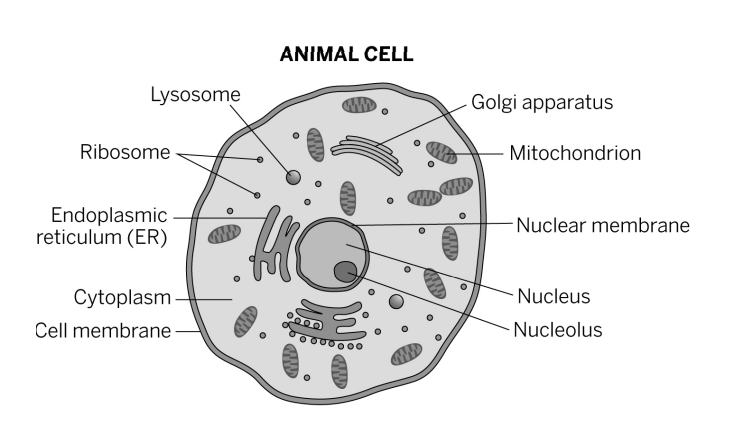
Animal cells have structures that perform specific functions in the cell. Mitochondria are organelles that float within the cell. Because they produce most of the cell’s energy, mitochondria are nicknamed the “powerhouse of the cell.” Which of the following types of cells would have the greatest number of mitochondria? a. skin cell
b. blood cell
c. muscle cell
d. fingernail cell
c. muscle cell
Reason: Muscle cells have the greatest number of mitochondria because muscle cells
need a lot of energy to move body structures.
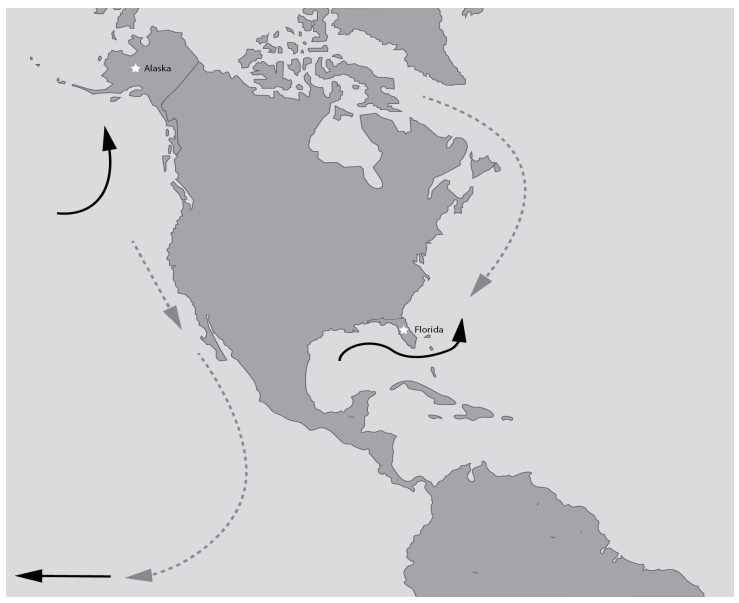
How do the currents off the coast of Florida and Alaska compare? a. Although they are both warm currents, the one off of Florida’s coast has less energy.
b. Although they are both cold currents, the one off of Alaska’s coast has more energy.
c. Although they are both cold currents, the one off of Alaska’s coast has less energy.
d. Although they are both warm currents, the one off of Florida’s coast has more energy.
d. Although they are both warm currents, the one off of Florida’s coast has more energy.
Reason: They are both warm currents, but since the one off of Florida’s coast originated closer to the equator, it has more energy than the one near Alaska.
The images below show how Bangalore, a large city in India, changed from 1973 to 2006.
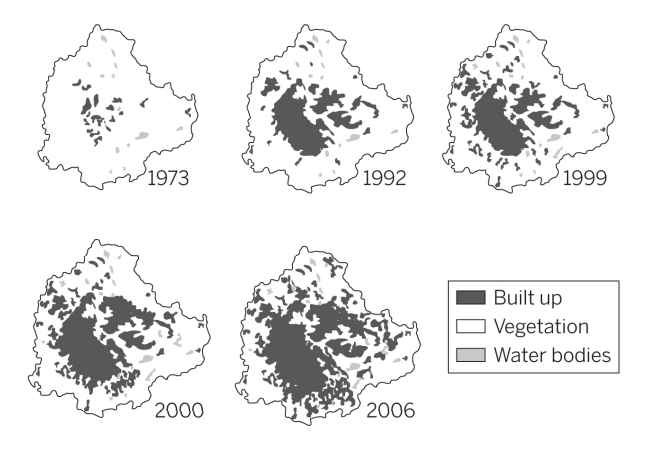
A biologist living in Bangalore notices that the trends in these images could pose challenges to elephants living just outside of the city. She considers a few plans to help the elephants. Her goals are to:
1. help the elephants survive the problem illustrated in the images, and
2. not harm people.
Which of the following plans would best meet the biologist’s goals?
a. creating a protected wildlife sanctuary for the elephants
b. convincing people to stay in the city instead of moving outward
c. gathering a team of veterinarians to care for the elephants when they need help
d. establishing affordable housing in the suburbs of the city for the growing population
a. creating a protected wildlife sanctuary for the elephants
Reason: This plan would not solve all of the problems of overpopulation, but it would protect the elephants from its effects and leave people unharmed.
Students watch the national weather report, in which the meteorologist predicts that a warm air mass and cold air mass are going to meet as shown on the map below.
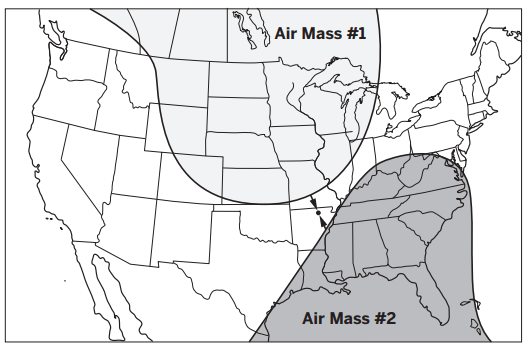
Which is the most likely weather condition that will occur at the location where the two air masses meet?
A cloudy and rainy day.
Reason: clouds and rain are the most likely weather condition because the warm air mass contains moisture and these air masses usually result in precipitation.